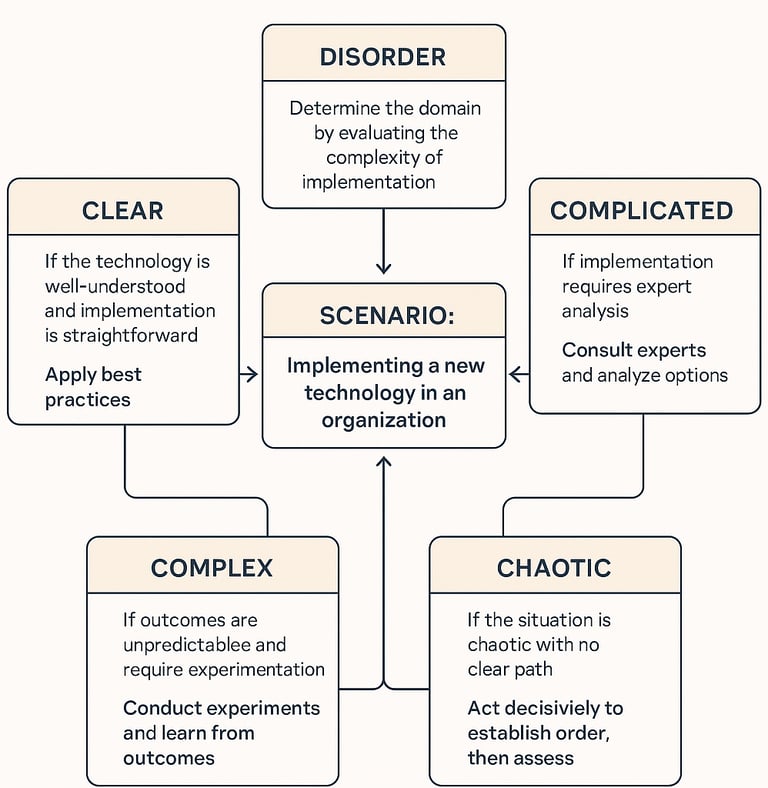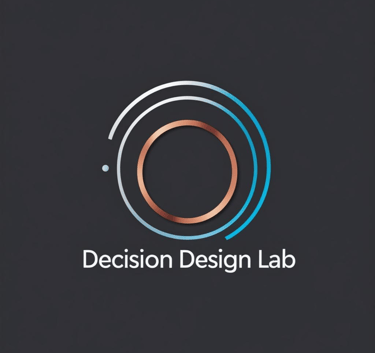Cynefin (kuh-NEV-in) Framework
Overview
The Cynefin Framework (pronounced kuh-NEV-in) is a conceptual model designed to aid decision-making by categorizing problems into five distinct domains: Clear, Complicated, Complex, Chaotic, and Disorder. Developed by Dave Snowden in 1999, the framework assists leaders in understanding the nature of the situations they face and determining appropriate responses based on the domain characteristics.
Each domain represents a different context:
• Clear: Situations with clear cause-and-effect relationships, where best practices apply.
• Complicated: Situations where cause-and-effect relationships exist but aren't immediately apparent, requiring expert analysis.
• Complex: Situations where cause-and-effect relationships are only apparent in hindsight, necessitating experimentation.
• Chaotic: Situations with no discernible cause-and-effect relationships, demanding immediate action to establish order.
• Disorder: Situations where it's unclear which of the other domains apply.
By identifying the domain of a situation, decision-makers can adopt strategies best suited to the context, enhancing their ability to respond effectively.
Origin
The Cynefin Framework was created in 1999 by Dave Snowden during his tenure at IBM Global Services. Drawing from his background in knowledge management and complexity science, Snowden developed the framework to help organizations navigate complex decision-making environments.
The term "Cynefin" is a Welsh word meaning "habitat" or "place," reflecting the framework's emphasis on context in understanding and responding to situations.
Evolution
Since its inception, the Cynefin Framework has evolved through continuous refinement and application across various domains. Initially comprising four domains, the framework later incorporated the Disorder domain to account for situations where the nature of the problem is unclear. Over time, the framework has been adopted in fields such as healthcare, education, and public policy, demonstrating its versatility in addressing complex challenges.
Significant Use Cases
• Organizational Strategy: Assisting leaders in determining appropriate management approaches based on the complexity of situations.
• Crisis Management: Guiding responses to emergencies by identifying the nature of the crisis and suitable interventions.
• Public Policy Development: Informing policy decisions by understanding the complexity of societal issues.
• Healthcare: Enhancing patient care by recognizing the complexity of medical conditions and tailoring treatment approaches.
Use Case Categories
• Leadership & Management
• Crisis Response
• Strategic Planning
• Public Policy
• Healthcare
Sample Use Cases and Step-by-Step Guide
Scenario: Implementing a new technology in an organisation.
1 Assess the Situation: Determine the domain by evaluating the complexity of the implementation.
2 Identify the Domain:
◦ If the technology is well-understood and implementation is straightforward, it's in the Clear domain.
◦ If implementation requires expert analysis, it's Complicated.
◦ If outcomes are unpredictable and require experimentation, it's Complex.
◦ If the situation is chaotic with no clear path, it's Chaotic.
3 Apply Appropriate Strategy:
◦ Clear: Apply best practices.
◦ Complicated: Consult experts and analyze options.
◦ Complex: Conduct experiments and learn from outcomes.
◦ Chaotic: Act decisively to establish order, then assess.
Decision Design Lab Interpretation
At Decision Design Lab, we view the Cynefin Framework as a vital tool for enhancing decision-making through contextual awareness. By recognizing the nature of the challenges faced, individuals and organizations can adopt strategies that align with the complexity of their situations, leading to more effective and adaptive outcomes.
Scholarly Links
• Snowden, D. J., & Boone, M. E. (2007). A Leader's Framework for Decision Making. Harvard Business Review. Link
• Kurtz, C. F., & Snowden, D. J. (2003). The new dynamics of strategy: Sense-making in a complex and complicated world. IBM Systems Journal, 42(3), 462–483.
Essential Reads & Interpretations
• Snowden, D. J., & Boone, M. E. (2007). A Leader's Framework for Decision Making. Harvard Business Review Press.
• Kurtz, C. F., & Snowden, D. J. (2003). The new dynamics of strategy: Sense-making in a complex and complicated world. IBM Systems Journal.
Authors
• Dave Snowden: Creator of the Cynefin Framework and founder of The Cynefin Company.
• Cynthia Kurtz: Collaborator with Snowden on the development of the framework.
Author/Framework Website
The Cynefin Company: Official website providing resources and information on the Cynefin Framework.
Video Links
The Cynefin Framework - Dave Snowden: An introduction to the framework by its creator.




